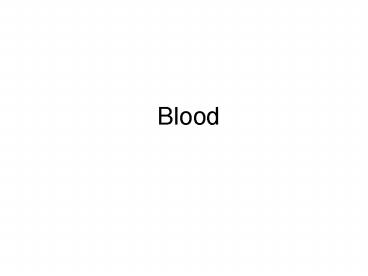Blood - PowerPoint PPT Presentation
1 / 15
Title:
Blood
Description:
Each mm3 of human blood contains around 5 million red blood cells, 5 000 to 10 ... in the blood of most molluscs, and some arthropods such as the horseshoe crab. ... – PowerPoint PPT presentation
Number of Views:49
Avg rating:3.0/5.0
Title: Blood
1
Blood
2
Some Facts About Blood and Blood Cells
Density 1.055 1.065 g/mL pH 7.3 7.4
(slightly on the alkaline side of
neutral) Volume 5 L (Precise volume depends
on body mass. Blood volume represents about
7.7 of body weight.) Each mm3 of human blood
contains around 5 million red blood cells, 5 000
to 10 000 white blood cells, and 250 000 to 500
000 platelets. Red blood cells have a life span
of about 4 months. White blood cells only live
for a few days.
Human blood is red, not blue. Oxygenated blood
is a brighter red than carboxylated blood. The
deeper red colour of carboxylated blood can be
observed when blood is withdrawn from an arm vein
for testing. Some animals do have blue or
colourless blood. This curious fact is due to the
oxygen carrying protein in the blood cells.
3
More About the Colour of Blood
The red colour of blood is due to protein
hemoglobin. Hemoglobin, also spelled haemoglobin
and abbreviated Hb or Hgb, is the
iron-proteincontaining oxygen-transport
metalloprotein in the red blood cells of the
blood in vertebrates and other animals. In
mammals the protein makes up about 97 of the red
cells dry mass, and around 35 of the total
content (including water). Hemoglobin transports
oxygen from the lungs or gills to the rest of the
body, such as to the muscles, where it releases
the oxygen.
Hemocyanins or heaemocyanins are respiratory
proteins in the form of metalloproteins
containing two copper atoms that reversibly bind
a single oxygen molecule (O2). Oxygenation causes
a colour change between the colorless Cu(I)
cuprous form and the blue Cu(II) cupric form.
Hemocyanins carry oxygen in the blood of most
molluscs, and some arthropods such as the
horseshoe crab. They are second only to
hemoglobin in biological popularity of use in
oxygen transport. Adapted from Wikipedia. The
links are to other intries in Wikipedia.
4
The Composition of Blood
H2O 50 Proteins antibodies enzymes
4 Wastes urea, uric acid ammonia Nutrients
glucose, amino acids, fats, cholesterol Minerals
Na, K, Ca Anions PO4-3, CO3-2 Gases O2 ,
CO2, N2
PLASMA 55
White Blood Cells (leukocytes) kill bacteria
Red Blood Cells (erythrocytes) 44 gas
transport Platelets (thrombocytes) clot blood
Blood Cells 45
5
Blood Cells
6
Erythrocytes
http//www.healthsystem.virginia.edu/internet/hema
tology/HessImages/Erythrocyte-100x-website-arrow.j
pg
7
This is a scanning electron microscope image from
normal circulating human blood. One can see red
blood cells, several white blood cells including
lymphocytes, a monocyte, a neutrophil, and many
small disc-shaped platelets. Red cells are
nonnucleated and contain hemoglobin, an important
protein which allows the cell to carry oxygen to
other parts of the body. They also carry carbon
dioxide away from the lungs. The
infection-fighting white blood cells are
classified in two main groups granular and
agranular. Granulocytes are formed in bone
marrow agranulocytes are produced by lymph nodes
and spleen. There are two types of agranulocytes
lymphocytes, which fight disease by producing
antibodies and thus destroying foreign material,
and monocytes. Platelets are tiny cells formed in
bone marrow and are necessary for blood clotting.
http//upload.wikimedia.org/wikipedia/commons/8/82
/SEM_blood_cells.jpg
8
Neutrophils are recognizable by their lobed
nuclei.
http//pathmicro.med.sc.edu/ghaffar/neutrophil.jpg
9
Eosinophils often have bilobe nuclei.
http//pathmicro.med.sc.edu/ghaffar/eosinophil.jpg
10
Basophil
http//www.healthsystem.virginia.edu/internet/hema
tology/HessImages/Mature-basophil-100x-website-arr
ow.jpg
11
Lymphocyte
http//www.healthsystem.virginia.edu/internet/hema
tology/HessEDD/Normal-hematopoietic-cells/Small-ly
mphocyte.cfm
12
Monocyte
http//www.healthsystem.virginia.edu/internet/hema
tology/hessidb/normal-hematopoiesis.cfm
13
Thrombocytes (Platelets)
http//www.healthsystem.virginia.edu/internet/hema
tology/HessImages/Platelets-100x-website-arrow.jpg
14
SBI 3UW Assignment
- Examine the prepared microscope slide of human
blood using the microscope. You will need to
obtain an image under low power and then migrate
through medium to high power.
- Determine your mass using the bathroom scale
available in the room. Refer to the information
in slide 2 to calculate your blood volume based
on your weight.
- Briefly summarize the appearance (structure) and
function of each type of blood cell. This type
of summary is organized as a table.
- View video 1 available at the link below. What
information in your summary table above is
lacking in this animation?
Video 1 http//www.youtube.com/watch?vJv2CKN
bkwJU
- View video 2 Some of the information in this
animation is very general. What specific
information could be added to the narration to
make it more informative.
Video 2 http//www.britannica.com/new-multimedi
a/mp4/vastv1333.mp4
- Use the information gleaned from the text book
readings and the above to list the functions of
blood.
15
Text References McGraw-Hill Biology 11 Blood
The Transport Medium, pp 292 301 Campbell
Biology pp 882 - 884































